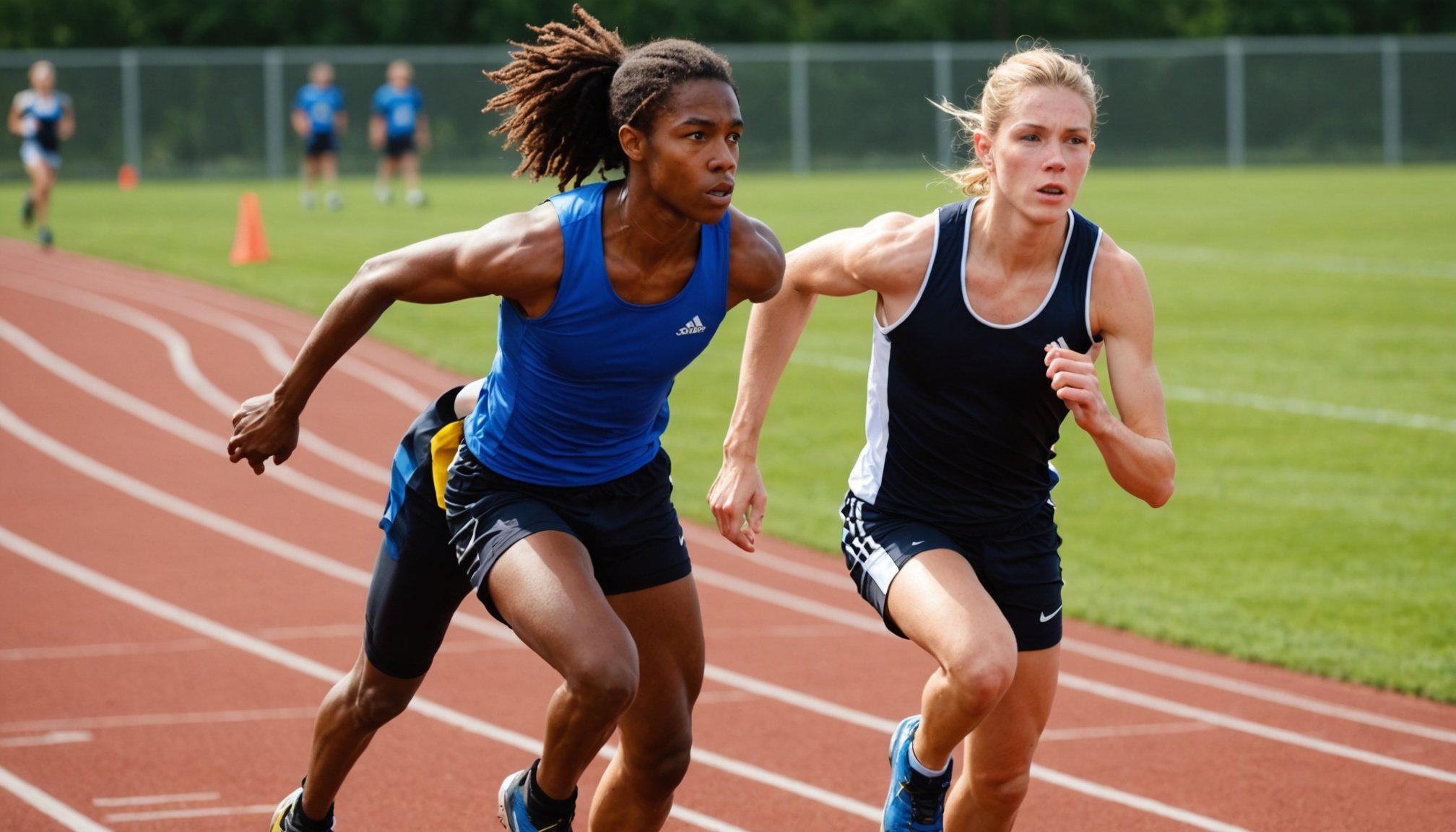Top Strategies to Safeguard Adolescent Track Athletes from Overtraining Risks
Understanding the Risks of Overtraining in Young Athletes
Overtraining is a significant concern for adolescent track athletes, as it can lead to a range of physical, mental, and emotional issues that can impact their performance, health, and overall well-being. To address this, it’s crucial to understand the factors that contribute to overtraining and implement strategies to prevent it.
Growth and Development Considerations
Adolescent athletes are in a critical phase of growth and development. Their bodies are undergoing significant changes, and their nutritional needs, training capacities, and recovery times are different from those of adult athletes. For instance, during growth spurts, adolescents may require more calories and nutrients to support both their athletic activities and their overall growth.
Also to see : Mastering Disc Golf: The Ultimate Grip Technique for Enhanced Throwing Accuracy
Common Risk Factors
Several factors increase the risk of overtraining in young athletes:
- Inadequate Nutrition: Insufficient calorie and nutrient intake can lead to energy deficits, a key component of the Relative Energy Deficiency in Sport (RED-S) syndrome. This condition can result in decreased performance, increased risk of injury, and long-term health consequences.
- Improper Training Loads: Increasing training intensity and volume too quickly can lead to overtraining. It is essential to balance training loads with adequate recovery periods to prevent overuse injuries.
- Early Sports Specialisation: Focusing on a single sport too early can lead to overuse injuries and burnout. Encouraging participation in various sports supports balanced athletic development and reduces the risk of overtraining.
Monitoring and Adjusting Training Programs
Tracking Progress and Adjusting Training Loads
Regularly tracking an athlete’s progress is vital for preventing overtraining. Here are some strategies:
Also to discover : Mastering Mental Focus: The Ultimate Guide to Preparing for Success in Competitive Diving
- Use Biometric Devices: Tools like the Garmin Forerunner, Whoop Strap, or Oura Ring can track detailed metrics such as heart rate variability, sleep quality, and resting heart rate. These metrics help assess recovery levels and prevent overtraining.
- Adjust Training Schedules: Training programs should be designed to balance intensity, volume, and recovery periods. Progressively increasing training intensity and volume with adequate rest periods ensures safe progression and minimizes injury risk.
Example of a Balanced Training Program
| Day | Activity | Intensity | Volume | Recovery |
|---|---|---|---|---|
| Monday | Strength Training | High | 45 minutes | Light stretching |
| Tuesday | Track Practice | Moderate | 60 minutes | Foam rolling |
| Wednesday | Rest Day | – | – | Active recovery (e.g., light walk) |
| Thursday | Cross-Training | Moderate | 45 minutes | Yoga or Pilates |
| Friday | Track Practice | High | 60 minutes | Cool-down exercises |
| Saturday | Rest Day | – | – | Active recovery (e.g., light swim) |
| Sunday | Long Run | Low | 90 minutes | Full rest day |
Nutrition and Recovery
Comprehensive Nutrition Education
Proper nutrition is essential for athletic performance and recovery. Here are some key points:
- Balanced Diet: Ensure athletes consume balanced amounts of energy, macronutrients (carbohydrates, proteins, and fats), and micronutrients. For example, lean proteins like chicken breast and fish, whole grains like quinoa, and healthy fats like avocados are crucial.
- Meal Timing and Preparation: Educate athletes on meal preparation and timing. Encourage them to eat larger portions, eat more frequently (every 2-3 hours), and include calorie-dense foods in their diet.
Practical Nutrition Tips
- Pre-Workout Nutrition: Encourage athletes to consume a balanced meal or snack 1-3 hours before training, including carbohydrates, proteins, and healthy fats.
- Post-Workout Nutrition: After training, athletes should consume a mix of carbohydrates and proteins within 30-60 minutes to aid in recovery.
- Hydration: Emphasize the importance of proper hydration before, during, and after training.
Educating Athletes, Coaches, and Parents
Importance of Education
Education is a powerful tool in preventing overtraining. Here’s how to educate key stakeholders:
- Comprehensive Sports Nutrition Education: Integrate sports nutrition education into schools and sporting organizations. This should cover macronutrients, hydration, meal preparation, and meal timing. It should also address the risks and signs of eating disorders and the importance of mental health.
- Parent/Guardian Involvement: Encourage parents/guardians to be involved in fostering healthy eating habits by involving adolescents in meal planning, cooking, and grocery shopping. This helps build practical skills and reinforces positive attitudes toward food and body image.
Promoting Healthy Body Standards
- Focus on Health Over Appearance: Foster a culture that emphasizes performance via health rather than appearance. Parents, coaches, and peers should model body-positive attitudes to help athletes focus on achieving their personal best rather than conforming to unrealistic body ideals.
Mental Health and Well-being
Recognizing Mental Health Symptoms
Mental health is closely linked to physical health and performance. Here are some points to consider:
- Monitoring Mental Health: Use biometric devices that track heart rate variability (HRV), stress levels, or brain activity to monitor mental health. Lower HRV is often associated with stress and poor mental health.
- Mindfulness and Relaxation: Encourage athletes to engage in mindfulness practices such as meditation or deep breathing exercises. These can help reduce anxiety, improve focus, and enhance mood.
Example of Mental Health Support
- Regular Check-ins: Schedule regular check-ins with athletes to discuss their mental health and well-being.
- Access to Counselling: Provide access to counselling and support services for athletes experiencing mental health issues.
Policy and Advocacy
Advocating for Healthy Environments
Creating supportive environments is crucial for preventing overtraining and promoting overall health.
- Policy Changes: Advocate for policies that support access to healthy food options within schools and sports clubs. Promote the development of nutrition and mental health education programs to prevent disordered eating and other health issues.
- Availability of Nutritious Meals: Ensure the availability of nutritious meals and snacks that support athletic performance and overall health.
Preventing overtraining in adolescent track athletes requires a multifaceted approach that includes monitoring and adjusting training programs, ensuring proper nutrition and recovery, educating athletes and their support systems, promoting mental health and well-being, and advocating for supportive environments.
Final Tips for Parents, Coaches, and Athletes
- Stay Informed: Stay updated with the latest research and trends in sports medicine and nutrition.
- Be Patient: Recognize that progress takes time and that it’s important to focus on the process rather than the outcome.
- Prioritize Recovery: Ensure that recovery is a part of the training program, including rest days, proper nutrition, and adequate sleep.
By implementing these strategies, we can safeguard the health, performance, and well-being of adolescent track athletes, ensuring they have a positive and successful athletic journey.











